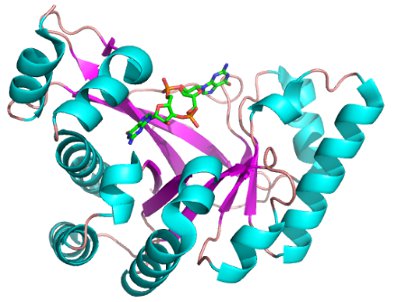Team:Glasgow/PDE
From 2011.igem.org
(Difference between revisions)
| Line 2: | Line 2: | ||
<html> | <html> | ||
<h1>C-Di-GMP Phosphodiesterase</h1> | <h1>C-Di-GMP Phosphodiesterase</h1> | ||
| - | <h6><a href"https://2011.igem.org/Team:Glasgow/Parts">Back to Parts</a></h6> | + | <h6><a href="https://2011.igem.org/Team:Glasgow/Parts">Back to Parts</a></h6> |
<table border="0"> | <table border="0"> | ||
<tr> | <tr> | ||
Revision as of 03:44, 22 September 2011

C-Di-GMP Phosphodiesterase
Back to Parts
| Phosphodiesterases are a family of enzymes naturally present in microorganisms, which break phosphodiester bonds. The specific enzyme we are using breaks the phosphodiester bond in the second messenger nucleotide, cyclic digaunylate (cyclic-di-GMP). Cyclic-di-GMP is important in many bacterial processes, including biofilm formation, motility and virulance. The phosphodiesterase regulates signal transduction by controlling levels of the signalling molecule in cells. High cellular levels of c-di-GMP are required to trigger behaviour that is crucial to biofilm formation. For example in E. Coli c-di-GMP binds to the protein YcgR which is a member of the PilZ(+) family of effector proteins which in turn triggers decreased flagella activity. If this signal is stopped the bacteria will increase flagella activity causing the biofilm disperse. This approach of quenching the c-di-GMP signal has been shown to disperse biofilm by (Ma et al). This enzyme was amplified from the genome of Pseudomonas aeruginosa strain PA01. The enzyme contains a domain (vieA) which specifically targets the cyclic-di-GMP molecule and an EAL domain that that performs the catalytic function. We are using the enzyme under conditional promoters to control the levels of cyclic-di-GMP within the cell. We expect that the targeted expression of phosphodesiterase could be used to interfere with biofilm formation or to trigger dispersal. |  Figure 1: The structure and function of C-Di-GMP. C-Di-GMP is created by the enzyme deguanylate cyclases and is broken down by phosphodiesterases. High levels are of c-di-GMP activate functions that are necessary for biofilm growth. Image from "Principles of c-di-GMP signalling in bacteria" by Regine Hengge.
Figure 1: The structure and function of C-Di-GMP. C-Di-GMP is created by the enzyme deguanylate cyclases and is broken down by phosphodiesterases. High levels are of c-di-GMP activate functions that are necessary for biofilm growth. Image from "Principles of c-di-GMP signalling in bacteria" by Regine Hengge.
|
 "
"

